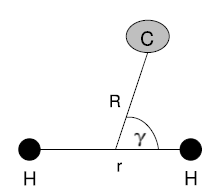Conical intersections in triplet excited states of methylene from the anti-Hermitian contracted Schrödinger equation
James W. Snyder, Adam E. Rothman, Jonathan J. Foley IV and David A. Mazziotti
J. Chem. Phys.
2010

A conical intersection in triplet excited states of methylene is computed through the direct calculation of two-electron reduced density matrices (2-RDMs) from solutions of the anti-Hermitian contracted Schrödinger equation (ACSE). The study synthesizes recent extensions of the ACSE method for the treatment of excited states [G. Gidofalvi and D. A. Mazziotti, Phys. Rev. A 80, 022507 (2009)] and arbitrary-spin states [A. E. Rothman, J. J. Foley, and D. A. Mazziotti, Phys. Rev. A 80, 052508 (2009)]. We compute absolute energies of the 1B311 B31, 1A321 A32, and 2B312 B31 states of methylene (CH2)(CH2) and the location of the conical intersection along the 1A32−2B311 A32−2 B31 potential-energy surfaces. To treat multireference correlation, we seed the ACSE with an initial 2-RDM from a multiconfiguration self-consistent field (MCSCF) calculation. The ACSE produces energies that significantly improve upon those from MCSCF and second-order multireference many-body perturbation theory, and the 2-RDMs from the ACSE nearly satisfy necessary NN-representability conditions. Comparison of the results from augmented double-zeta and triple-zeta basis sets demonstrates the importance of augmented (or diffuse) functions for determining the location of the conical intersection.